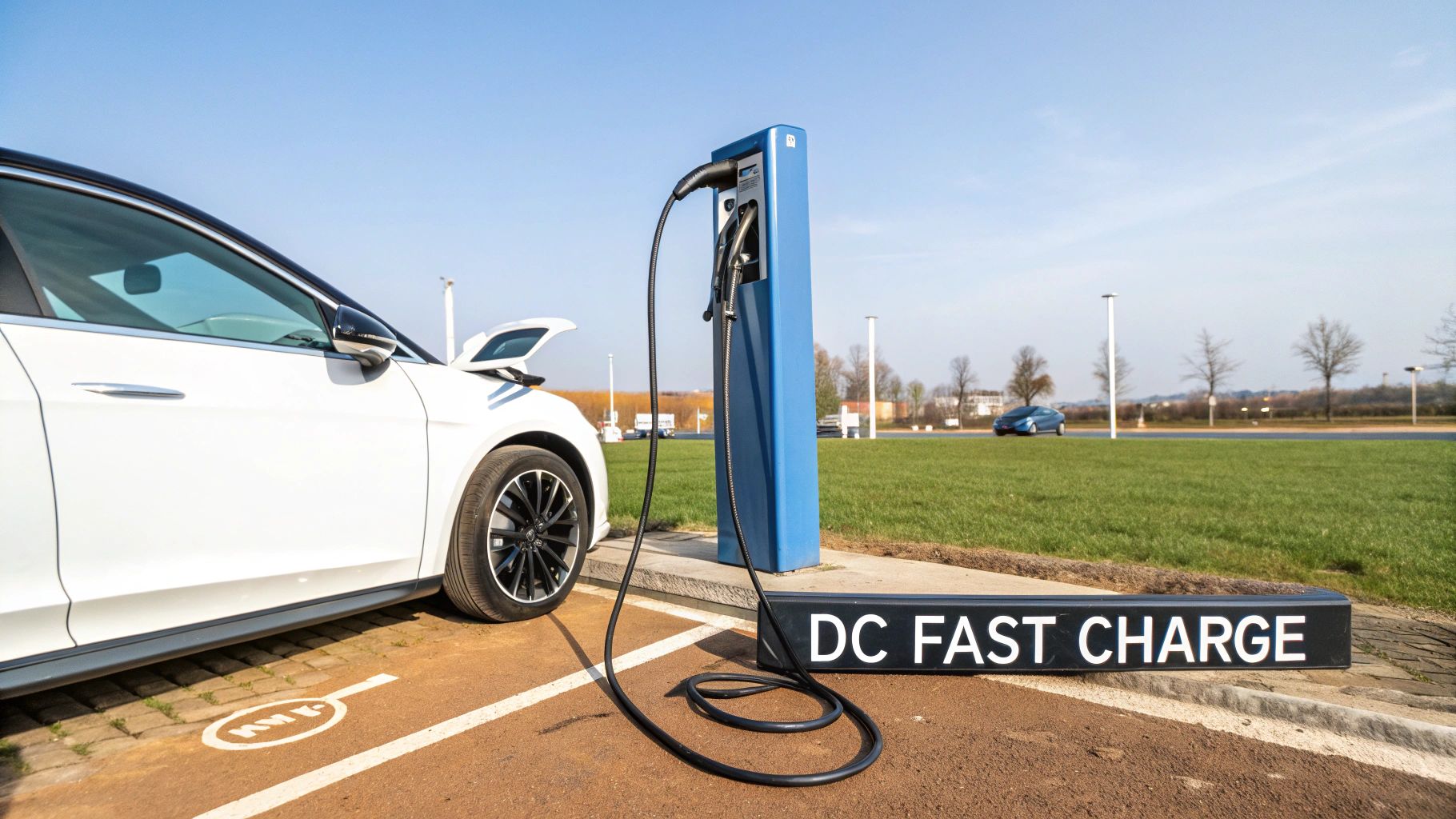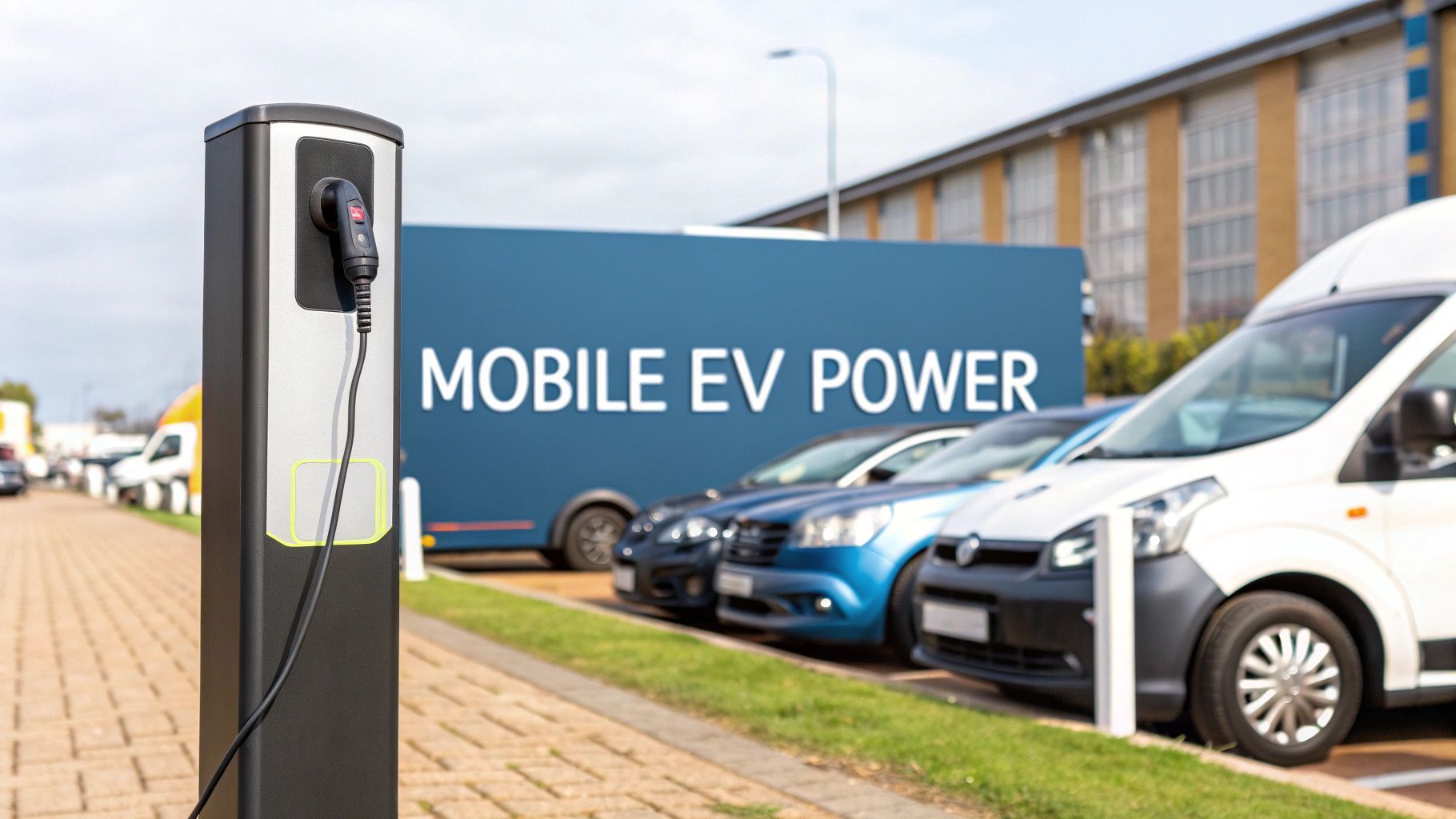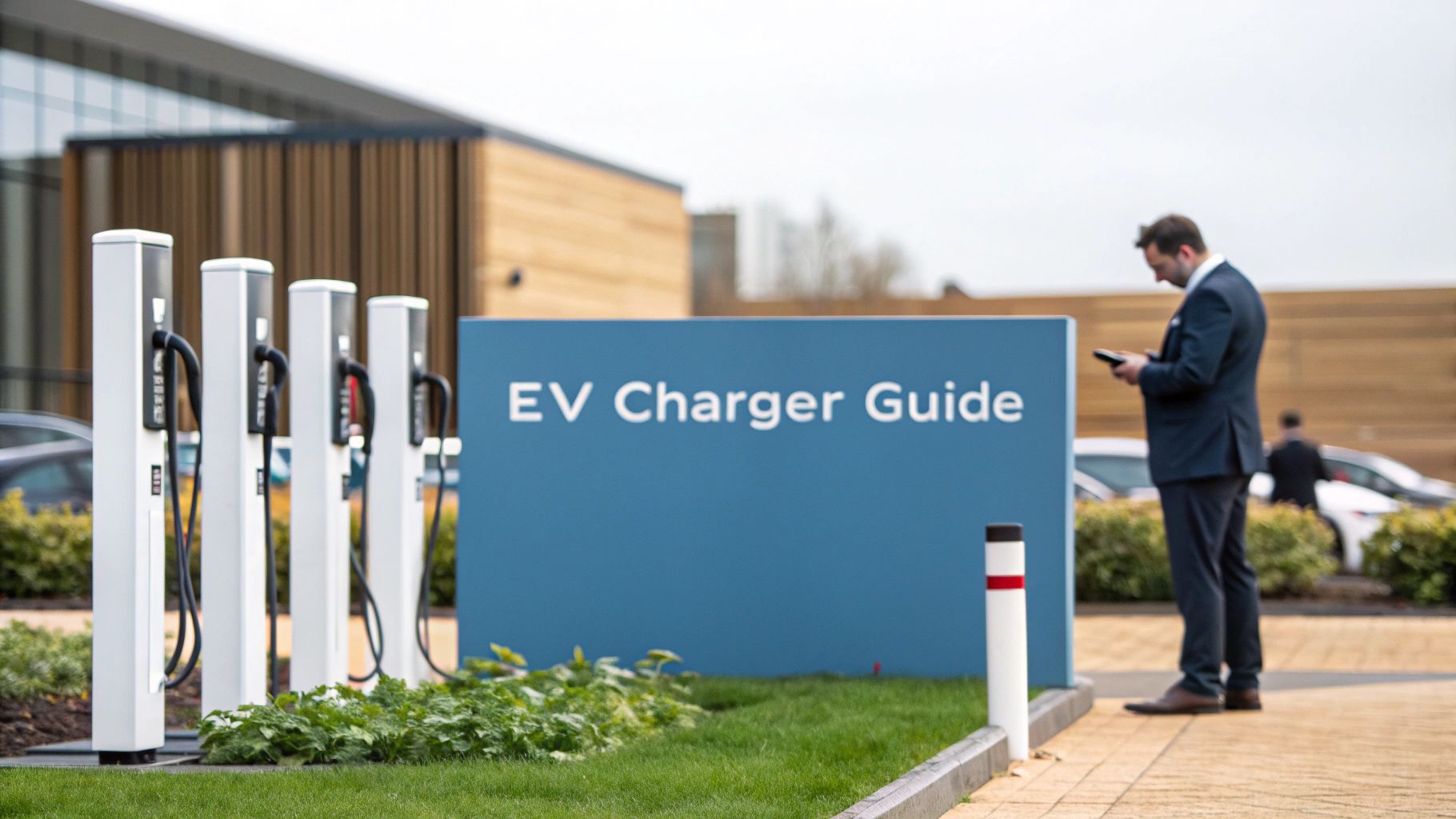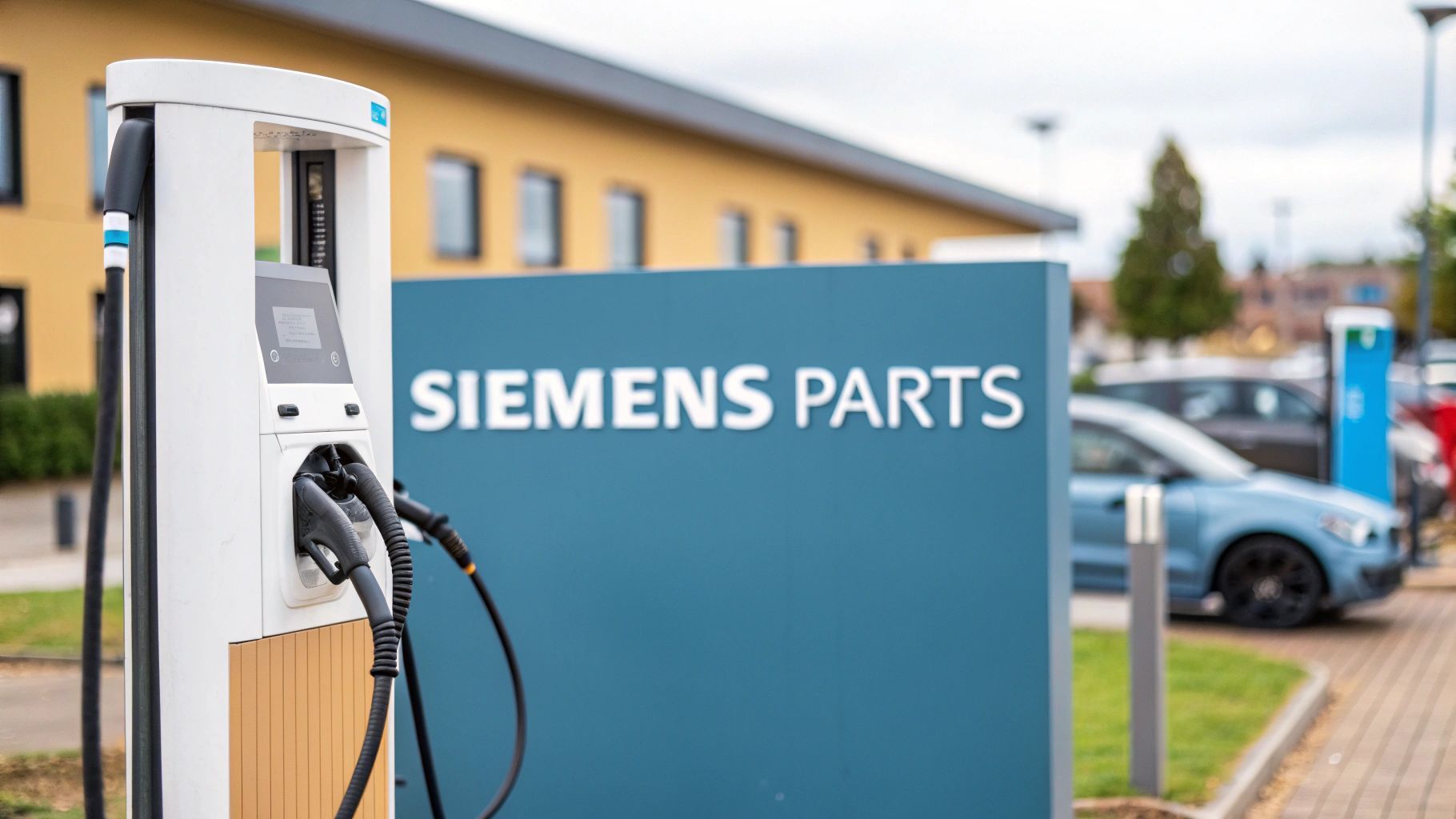DC Fast Charge: The Ultimate Guide to Rapid EV Charging
A DC fast charge is the quickest way to get power into your electric vehicle, delivering high-power Direct Current (DC) electricity straight to the battery. It completely changes the game for EV drivers, slashing charging times when compared to standard AC chargers.
This technology is what makes long-distance EV travel not just possible but practical. In many cases, you can add over 100 miles of range in just 10-15 minutes. It works by bypassing your car's slower internal converter, making it the most powerful and rapid way to recharge on the move.
The Core of Rapid EV Charging

Think of your EV's battery as a bucket you need to fill with water. Your standard home or workplace charger (AC charging) is like using a garden hose. It’s reliable and gets the job done overnight but it’s slow.
A DC fast charge , on the other hand, is like calling in the fire brigade to fill that same bucket with a high-pressure hose. It's done in minutes.
This incredible speed difference all comes down to one crucial step: electrical conversion. The UK’s National Grid supplies Alternating Current (AC) but your EV battery—like every other battery—can only store Direct Current (DC).
When you use a standard AC charger at home, your car’s small, built-in onboard charger has the slow job of converting that AC power into DC. This component has its limits. DC fast chargers change everything by doing this conversion externally with much larger, more powerful equipment. The station sends DC power directly to the battery, completely bypassing the car's internal bottleneck.
To get a clearer picture of how these two methods stack up, here’s a quick comparison.
AC vs DC EV Charging: A Quick Comparison
| Feature | AC Charging (Home & Public) | DC Fast Charge (Public) |
|---|---|---|
| Location | Home, workplace, public car parks | Motorway services, public hubs, forecourts |
| Speed | Slow (hours for a full charge) | Rapid (minutes for a significant top-up) |
| Power Output | 3.6kW - 22kW | 50kW - 350kW+ |
| Conversion | Done by the car's onboard charger | Done by the charger station itself |
| Best For | Overnight charging, daily top-ups | Long journeys, quick turnarounds |
As you can see, they serve very different purposes. AC is for when you have time and DC is for when you don't.
Why This Speed Matters for UK Drivers
The ability to recharge an EV in the time it takes to grab a coffee is fundamental to widespread adoption. For drivers up and down the country, the benefits of a strong DC fast charge network are immediate and tangible.
- Enables Long-Distance Journeys: Rapid charging hubs on motorways and A-roads make it easy to travel the length of the UK with minimal fuss, effectively putting range anxiety in the rear-view mirror.
- Supports Urban Drivers: For the millions of UK residents in flats or terraced houses without off-street parking, public DC fast charging is the key that unlocks EV ownership.
- Boosts Commercial Fleets: Delivery vans, taxis and service vehicles can get back on the road in minutes, which minimises costly downtime and keeps businesses running efficiently.
A DC fast charge station is more than just a convenience—it's a vital piece of infrastructure. It provides the freedom and flexibility that drivers have come to expect, making electric vehicles a practical choice for everyone.
Ultimately, this technology is the bridge that takes EV ownership from a niche option to a mainstream reality for every driver in the UK.
The UK's Rapid DC Fast Charge Network Expansion
The UK’s public charging network is growing at a phenomenal pace and DC fast charge stations are the ones leading the charge. This isn't happening by accident; it's a direct response to the surge in EV ownership and a critical step in building driver confidence for the long haul. With serious investment from both private firms and government initiatives, our motorways and city centres are quickly becoming reliable hubs for a rapid top-up.
But this expansion is about more than just numbers on a map. It’s a fundamental upgrade to the quality and speed of the entire network. The focus has decisively shifted towards rapid and ultra-rapid DC technology—a strategic move designed to slash charging times, eliminate queues and make long-distance electric journeys feel just as effortless as their petrol-powered counterparts.
A Data-Driven Look at the Growth
The numbers tell a powerful story. In the first half of one recent year alone, a staggering 1,598 new ultra-rapid chargers (those delivering 150 kW or more) went live, marking a 23% increase . This surge brought the total number of these high-speed units to 8,619 , officially surpassing the number of standard rapid chargers for the first time. It's a huge milestone. You can get the full picture by reading more about the UK's impressive EV charging growth.
This signals a major shift in our national infrastructure strategy. While slower chargers certainly still have their place for overnight or workplace top-ups, the future of on-the-go public charging is unquestionably high-speed.
Overcoming Grid Constraints with Smart Technology
Of course, installing thousands of powerful DC fast chargers isn't as simple as just plugging them in. This kind of hardware puts immense strain on the National Grid, especially in areas where electrical capacity is already stretched thin.
To get around this, charge point operators are turning to some seriously clever energy solutions that work with the grid, not against it.
These solutions often involve a mix of:
- Grid-Scale Batteries: Think of these as massive power banks installed right at the charging hub. These battery energy storage systems (BESS) can quietly sip power from the grid during off-peak hours when electricity is cheap and plentiful.
- On-Site Renewables: You’ll increasingly see charging hubs topped with solar canopies. This allows them to generate their own clean, local power, reducing their reliance on the grid and making every charge that little bit greener.
- Distributed Energy Management: This is the brains of the operation. Advanced software intelligently juggles the flow of power between the grid, the on-site batteries, solar panels and the EV chargers themselves. It ensures drivers get a fast, reliable charge without tripping the local substation.
By blending EV charging with batteries and on-site renewables, the UK is building a charging network that’s not just fast but resilient and future-proof. This approach doesn't just enable the rapid roll-out of DC chargers; it actively strengthens our entire energy grid.
Decoding DC Fast Charge Power and Speeds
Not all DC fast chargers are created equal and understanding the difference is key to getting the most out of every charging stop. The kilowatt (kW) rating you see on a charger is simply a measure of its power output. Think of it like water pressure: a higher kW rating means a faster flow of energy into your EV's battery.
This power spectrum ranges from standard rapid chargers , which typically deliver around 50kW , to the much more muscular ultra-rapid chargers that can push out 150kW , 350kW or even more. This huge difference in power translates directly into time saved on the road.
Translating Kilowatts into Kilometres
So, what do these numbers actually mean for your journey? A 50kW rapid charger is perfect for a meaningful top-up, often adding around 100 miles of range in about 35-45 minutes. It’s ideal for grabbing lunch or doing a quick shop while your car gets a decent boost.
Ultra-rapid chargers, on the other hand, completely change the game for long-distance travel. A 150kW unit can deliver that same 100 miles of range in as little as 10-15 minutes—barely enough time for a coffee break. These powerful stations are what make EV road trips just as convenient as their petrol counterparts. For a deeper dive, you can learn more about the specifics of ultra-rapid EV charging technology.
The chart below really highlights the impressive growth of these ultra-rapid chargers compared to the total number of public charge points in the UK.

This data shows a clear trend: while the overall network is expanding, the focus on building out high-speed infrastructure is accelerating even faster.
Factors That Influence Your Real-World Speed
While the charger's kW rating is crucial, it’s not the only thing determining your charging speed. Several variables can affect how quickly your vehicle actually takes on power.
It's a common misconception that plugging into a 350kW charger guarantees you'll receive 350kW. The speed you get is a negotiation between the charger and your car and your vehicle's own capabilities play an equally important role.
Here are the main factors that come into play:
- Your Vehicle’s Maximum Charge Rate: Every EV has a maximum DC charging speed it can accept. A car with a 100kW limit will only ever charge at 100kW, even when it’s connected to a 350kW station.
- Battery State of Charge (SoC): An almost empty battery charges much faster than one that is nearly full. To protect the battery’s health and longevity, the charging speed slows down significantly after reaching about 80% .
- Battery Temperature: EV batteries have an optimal temperature range for charging. If the battery is too cold or too hot, the car's management system will automatically reduce the charging speed to prevent any damage.
Powering Chargers from a Constrained Grid
Rolling out DC fast charging across the UK is a huge win for electric mobility but it throws a massive challenge at our energy infrastructure. When you install a hub of ultra-rapid chargers, each one hungry for hundreds of kilowatts, you put an immense strain on the local electrical grid.
The reality is that many perfect locations for charging hubs—think remote motorway services or older industrial estates—simply don't have the grid capacity to cope.
This bottleneck is a serious hurdle. Upgrading a local substation or digging up roads to lay new high-voltage cables can be eye-wateringly expensive and take years to complete. This really slows down the expansion of the rapid charging network we so desperately need. Luckily, this challenge has sparked some truly clever solutions that work around grid limitations, creating powerful, self-sufficient charging ecosystems instead.
The Role of Grid-Scale Batteries
By far, the most effective solution is to bring in grid-scale batteries, often called Battery Energy Storage Systems (BESS). In simple terms, these are enormous, container-sized power banks installed right there on-site, next to the EV chargers. They act as a vital buffer, standing between the high-power chargers and a weak grid connection.
The BESS can quietly trickle-charge itself from the grid, usually during off-peak hours when electricity demand is low and prices are at their cheapest. Then, when an EV driver plugs in demanding a rapid charge, the battery instantly unleashes its stored energy at a high rate. It delivers all the power the charger needs without ever overwhelming the local grid. It’s a smart approach that makes it possible to deploy ultra-rapid charging hubs in places that would otherwise be off-limits.
A BESS-supported charging hub operates like a reservoir. It fills up slowly when water (energy) is abundant and cheap, then releases a powerful surge on demand—all without needing a bigger pipe connecting it to the main supply.
Combining Renewables for Energy Independence
Taking this idea one step further, many forward-thinking charging hubs now pair battery storage with their own on-site renewable energy generation. This creates a powerful, localised energy network, what's often called a distributed energy system.
This synergy brings even greater flexibility and sustainability to the table. Here’s a look at how the different parts work together:
-
Solar Canopies: Often built over the parking bays, these are brilliant because they serve two purposes at once: sheltering vehicles from the weather and generating clean electricity. The power they produce during the day can either go straight into a charging EV or be stored in the on-site battery for later.
-
Grid-Scale Batteries: The battery is the heart of the system. It stores any excess solar energy as well as low-cost off-peak electricity from the grid. It's then ready to provide that instant hit of power needed for a DC fast charge, smoothing out the peaks and troughs in both energy generation and demand.
-
Smart Energy Management: An advanced control system is the brain, orchestrating the flow of power between the solar panels, the battery, the grid and the EV chargers. This ensures everything runs at maximum efficiency and reliability, 24/7. To get a deeper understanding of how these systems work, you can explore this detailed guide to dynamic power management for EV charging.
To ease the pressure on the grid and guarantee reliable DC fast charging, businesses and even homes can look into smart solutions like integrating solar panel solutions for local power generation. This powerful combination of EV charging, batteries and renewables is the key to building a truly resilient and scalable charging network for the future.
Mobile Charging and Flexible Power Solutions

Welcome to the world of mobile EV charging . Think of a powerful DC fast charger, complete with its own large battery, all neatly packaged onto a trailer or built into a van. They're essentially giant 'power banks on wheels', ready to deliver a rapid charge without ever needing a grid connection on-site.
These self-contained systems are perfect for a huge range of situations where permanent chargers are impractical or just not possible. They're a lifeline for fleet depots testing out new charging strategies, a power source for events like festivals and exhibitions, or an emergency service for stranded EV drivers.
Powering EVs Anywhere
Mobile charging units are a game-changer because they completely separate rapid charging from grid constraints. Instead of bringing the car to the charger, the charger comes to the car. This simple switch opens up a new layer of convenience and support for the growing number of EV drivers on UK roads.
The technology cleverly combines two proven systems:
- High-Capacity Batteries: These integrated battery energy storage systems (BESS) hold enough energy for multiple rapid charges. They can be trickle-charged from a standard connection back at base and then deployed to deliver high-power DC charging in the field.
- Rapid DC Charging Hardware: The same powerful DC charging technology you find in fixed stations is built right into the mobile unit, ensuring drivers get the fast top-up they need.
This distributed energy model creates a decentralised and resilient solution. By placing power exactly where it’s needed, mobile charging helps accelerate EV adoption by filling critical gaps in the network, especially in remote or underserved areas.
A Flexible Future for Charging
The sheer versatility of these systems is their greatest strength. For businesses transitioning their vehicle fleets to electric, mobile units are a fantastic way to trial charging patterns and manage vehicle downtime without the major capital expense and disruption of installing permanent infrastructure.
They can be deployed to support seasonal demand at tourist hotspots or provide critical backup power during grid outages. These units represent a massive step forward in building a truly comprehensive charging ecosystem.
To see how these solutions are already making a difference, you can explore a deeper analysis of the permanent impact of portable power. Ultimately, mobile DC fast charge technology ensures that access to rapid, reliable power is never out of reach.
Navigating the UK’s DC Fast Charge Landscape
The UK's DC fast charge network is expanding at a serious pace but your experience finding a rapid charger can be wildly different depending on your postcode. The simple truth is that the availability of these crucial charge points varies massively across the country, creating a very real geographical divide.
City centres, especially London, are becoming hotspots with a high density of chargers. In contrast, many rural and remote areas are still playing catch-up, which throws a spanner in the works for drivers planning longer journeys. Getting to grips with this landscape is the key to navigating the UK confidently in an electric vehicle.
The Urban-Rural Charging Divide
So, why the imbalance? It really boils down to commercial and logistical factors. Charge point operators, quite naturally, prioritise locations with high traffic and population density to see a return on their investment. This means cities and busy motorway corridors get the lion's share of the shiny new rapid EV charging infrastructure first.
The regional data paints a stark picture of this commercial reality. While the UK averages 113 public EV charging devices per 100,000 people, London storms ahead with an impressive 263 chargers for the same number of residents. That figure is more than double any other region in the country, highlighting just how intense the focus on urban deployment is. You can dig into more of these insights on UK EV charging distribution at Uswitch.com.
This disparity isn't just an inconvenience; it's a genuine barrier to EV adoption for anyone living outside major cities. Closing this gap is absolutely essential if we want to build a truly comprehensive and fair national charging network.
Bridging the Gap for a National Network
Recognising this challenge, major efforts are now underway to create a more balanced network. Government incentives and strategic investments are finally starting to encourage the development of charging hubs in less populated areas. This push is vital for making sure every driver has reliable access to a DC fast charge , no matter where their journey starts or ends.
Solutions that tackle grid constraints are also playing a huge role here. The rollout of grid-scale batteries, often paired with on-site renewables, is making it commercially viable to install powerful charging stations even in places with weaker grid connections. As this kind of technology becomes more common, we can expect to see those rapid charging deserts finally begin to disappear from the map.
Your Questions About DC Fast Charging Answered
Getting to grips with the practical side of DC fast charging helps every EV driver use the network safely and efficiently. We get asked a lot of questions but a few pop up more than others.
Can I Use a DC Fast Charger for My EV Every Day?
You certainly can but it’s probably not the best idea. Most manufacturers actually advise against making it your only charging method and for good reason. The sheer power of a DC charger generates more heat and puts the battery under more stress than slower AC charging.
For your day-to-day needs, especially if you’re charging overnight, a home AC unit is the best way to look after your battery’s long-term health. Think of DC fast charging as your go-to for long journeys or when you’re caught short and need a big top-up in a hurry.
Why Does My Car Charge Slower as It Gets Fuller?
That’s a brilliant question and it’s all down to a crucial safety feature built into your car to protect its most valuable component: the battery. Your vehicle’s battery management system (BMS) is cleverly designed to dial back the charging speed as it nears full capacity, usually kicking in around the 80% mark.
This tapering effect is entirely intentional. It minimises heat build-up and reduces stress on the individual battery cells, which is vital for preserving their lifespan. It's also why that last 20% (from 80% to 100%) can often take just as long as it took to get from 20% to 80% in the first place.
What’s the Difference Between Rapid and Ultra-Rapid Charging?
The real difference boils down to power output, which directly translates to speed. Here in the UK, chargers labelled ‘rapid’ are typically 50kW DC units. Anything that delivers significantly more power—starting from 100kW and going all the way up to 150kW or even 350kW —is classed as ‘ultra-rapid’.
To put that into context, a 50kW rapid charger might add around 100 miles of range in about 35-45 minutes. An ‘ultra-rapid’ 150kW unit, on the other hand, could deliver that same 100 miles in as little as 10-15 minutes, provided your car is capable of handling that speed.
At ZPN Energy , we provide advanced rapid and ultra-rapid DC fast charge solutions, integrated with battery storage and energy management systems to power the future of transport. Discover our technology at zpnenergy.com.








